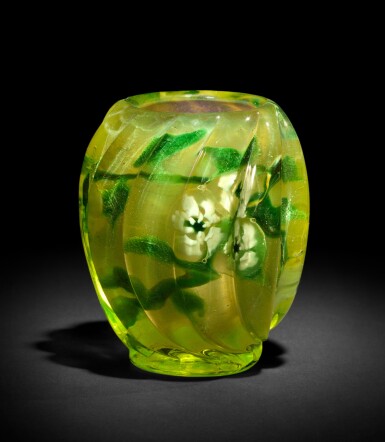The Doros Collection: The Art Glass of Louis Comfort Tiffany
The Doros Collection: The Art Glass of Louis Comfort Tiffany

Tiffany Studios
Carved "Dogwood" Paperweight Vase
Auction Closed
December 8, 12:14 AM GMT
Estimate
15,000 - 20,000 USD
Lot Details
Description
Tiffany Studios
Carved "Dogwood" Paperweight Vase
circa 1900
Favrile glass
engraved L.C.T. Ex
3¾ inches (9.5 cm) high
Leslie H. Nash, New York
John J. Nash, New York
Sotheby’s New York, November 19, 1983, lot 675
John and Katsy Mecom, Houston
Sotheby’s New York, October 3, 1992, lot 377
Paul Doros, The Art Glass of Louis Comfort Tiffany, New York, 2013, p. 138 (for the present lot illustrated)
This lot is accompanied by a photograph of the lot formerly belonging to and inscribed by Leslie Nash.
The Ideal Medium –
The "Paperweight" Technique
My parents avidly collected every type of object produced by Louis C. Tiffany’s numerous firms. My father, however, had a specific obsession which he frequently expressed: “You can never have enough paperweights!” He loved the technique and the incredible variety of decorative designs, always adding another example to the collection whenever possible.
Tiffany’s glasshouse never made what are considered to be traditional paperweights: hemispherical domes of thick, transparent glass encasing a design created with torchwork or millefiori. What are today known as the company’s paperweight-technique vases, however, frequently did employ millefiori encased between two relatively thin layers of clear glass and were an ideal medium to express Tiffany’s love of botany.
First developed around 1900, the glasshouse’s early attempts at paperweight vases were relatively crude and display the gaffers’ obvious problems with mastering the technique. The millefiori flowers were simple, poorly formed and indistinct, and many pieces have interior threads and inclusions that are visually distracting. However, the craftsmen perfected their skills within five years and paperweight vases of great beauty were produced by the company into the 1920s.
The group of paperweight vases offered here explicitly exhibits the artistic mastery and superior talents of Tiffany’s gaffers, of which there were less than a dozen in the glasshouse’s entire history. The “Dogwood” Vase (lot 207) of thick transparent glass, with carved ribs on the exterior, an interior gold iridescence and encasing pendant dogwood blossoms, is from the initial stage of paperweight production. The dogwood flower, with its simple and immediately recognizable form, was an intelligent choice of subject as the gaffers labored to refine their skills in employing this complex technique before attempting more elaborate blossoms, as seen in lot 208. The company, however, fully realized the importance of the vase and, according to Arthur Nash, it was displayed at the 1900 Paris Exposition Universelle.
The “Millefiori” Bowl (lot 208), with a thick eight-lobed base and made 15 years later, exhibits the technique at its finest. The transparent body, with a heavy gold-orange interior iridescence, encases beautifully formed large millefiori blossoms amid vivid green foliage, some of it continuing down to the transparent base. The piece has a special inscription signifying it as an exhibition piece and was likely part of Tiffany’s display at the 1915 Panama-Pacific International Exposition. The subtle texture on the rim gives fascinating insight into the making process and the inherent risk of attempting a work as ambitious as this. The marks on one side of the rim were created when the gaffer cut off the top of the glass bubble with his scissors and failed to have them smoothed out sufficiently in the glory hole, perhaps not wanting to risk any damage to this masterwork. Tiffany, however, embraced these types of minor imperfections, even selling cracked pieces, and encouraged his glassmakers to ignore what most companies would consider as flaws. This attitude ensured that each blown glass object was unique, a point the company frequently mentioned in its advertising. More importantly, all that truly mattered to Tiffany was the aesthetic appeal of the final product.
- PD
